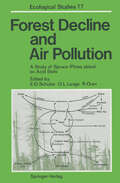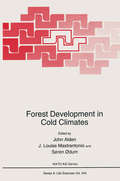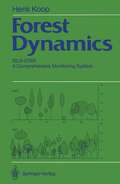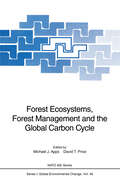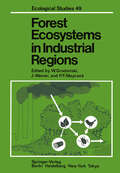- Table View
- List View
The Forest Certification Handbook
by Ruth Nussbaum Markku SimulaFirst published in 1995, The Forest Certification Handbook has become the landmark book concerning all aspects of forest and wood product certification from policy to business to in-the-field technical issues. Yet since first publication an enormous amount has happened in the field. This new second edition has been entirely rewritten to incorporate the changes over the past decade, and is a complete and up-to-date source of information on all aspects of developing, selecting and operating a forest certification programme that provides both market security and raises standards of forest management.
The Forest Certification Handbook
by Ruth Nussbaum Markku SimulaFirst published in 1995, The Forest Certification Handbook has become the landmark book concerning all aspects of forest and wood product certification from policy to business to in-the-field technical issues. Yet since first publication an enormous amount has happened in the field. This new second edition has been entirely rewritten to incorporate the changes over the past decade, and is a complete and up-to-date source of information on all aspects of developing, selecting and operating a forest certification programme that provides both market security and raises standards of forest management.
Forest Condition in a Changing Environment: The Finnish Case (Forestry Sciences #65)
by Eino MälkönenThe threats posed by air pollution and climate change have resulted in considerable public debate about forest condition and growth during the past two decades. Despite the massive input ofresearch resources, no clear answers have been found to these global questions. Although there have been substantial advances in our knowledge of the effects of air pollutants on the forests, many of the questions associated with forest condition are still open. Monitoring of forest condition at the national level started in Finland in 1985 in accordance with the methodology drawn up by the International Co-operative Programme on Assessments and Monitoring of Air Pollution Effects on Forests (ICP Forests, UN/ECE). Since then, research into forest condition and vitality has been one of the key areas in the research carried out by the Finnish Forest Research Institute. Three basic questions formed the starting point for the multidisciplinary, Forest Condition Research Programme: What changes are taking place in our forests? Why does forest condition vary, and why do trees appear to be suffering? How can forest condition be maintained through appropriate forest management? This report covers forest condition and changes in environmental factors on the of the latest findings, publications and expertise of researchers participated in basis the Forest Condition Research Programme. In addition to researchers from the Finnish Forest Research Institute, a large number of scientists from domestic and foreign universities and research institutes also made a considerable contribution to the research programme.
Forest conservation in protected areas of Bangladesh: Policy and community development perspectives (World Forests #20)
by Mohammad Shaheed Hossain ChowdhuryThis book dealt with a number of issues under the broad subject matter of protected area focusing on the policy of collaborative management as a means to augment the forest conservation activities and enhance community development in Bangladesh. Studies covered in the book emerged with the success stories of protected area co-management, both in terms of community development and biodiversity conservation. Significant level of development was noticed in the socio-economic conditions of the surrounding communities. Empowerment and improved social dignity of women participants signifies the initiation of co-management approach. The principles of participatory governance were found reasonably well reflected in legal and policy frameworks. Based on the lessons from the studies, a general metaphysical model, namely ‘Spider-web model of protected area co-management’ has been developed that can be potentially applicable in countries where local communities rely heavily on protected areas.
Forest Context and Policies in Portugal: Present and Future Challenges (World Forests #19)
by Fernando ReboredoThis book provides an up-to-date analysis of the Portuguese forests and forestry sector, including its history, its total economic value, current threats and opportunities and future challenges, namely the need to incorporate more planning and technology in forest management practices. The methodological approach of analysing the forestry sector in terms of its total economic value, and the use of this new perspective to correctly perceive the forest sector and to base development strategies is unique. Also, the use of new methods and technologies in the Portuguese forestry sector will be an opportunity to share these experiences with a wider international audience. For example, fire incidence during the summer has almost no parallel in the Western World, implying that Portuguese forest landscapes function as a “natural lab of wildfires” from which much can be learned globally. Thus, the outcomes of the fire management policies adopted might represent important lessons for Mediterranean basin countries.
Forest Decline and Air Pollution: A Study of Spruce (Picea abies) on Acid Soils (Ecological Studies #77)
by Roswitha AscheDuring the last decade, forest decline has become increasingly apparent. The decline in forest health was often reported to be associated with air pollution. The present study on Norway spruce stands in the Fichtelgebirge analyses various processes interacting within forest ecosystems. It covers transport and deposition of air pollutants, the direct effects of pollutants on above-ground plant parts, the responses of soil to acid rain, and the changing nutrient availability, and the accompanying effects on plant metabolism and growth. The role of fungi, microorganisms and soil animals in the decline of these stands is also assessed. The volume is concluded with a synthesis evaluation of the influence of different factors, and their interactions on forest decline.
Forest Decline and Atmospheric Deposition Effects in the French Mountains
by M. KaennelForest decline became a matter of public and scientific concern in France in 1983 when conifers in the Vosges mountains were found to exhibit unusual crown deterioration. An impassioned controversy on a supposedly large scale forest health problem was then in full swing in Central Europe. A co-ordinated research programme entitled DEFORPA ("Deperissement des For~ts et Pollution AtmospMrique") was launched in 1984. This programme ran from 1984 to 1991 and a number of projects are still in progress. The Programme was sponsored by three French ministries (Enviroument, Agriculture and Forestry, Research and Technologyl), several state agencies, various regional authorities and the Commission of the European Communities (DO xn and DG VI). Initially, emphasis was solely laid on the understanding of forest decline in the mountainous areas - because damage was most obvious there - in relation to natural and man-made factors. Air pollution was given high but not overwhelming priority. Thus, the DEFORPA Programme was not in its essence a nation-wide assessment of air pollution effects, unlike a number of national acidification research programmes in Europe and North America. During. the programme, however, the areas of concern expanded. In particular, research into water acidification in the Vosges mountains was developed in parallel with the DEFORPA Programme, and possible eutrophication of the ground flora in northeastern France became the subject of new research.
Forest Decline and Ozone: A Comparison of Controlled Chamber and Field Experiments (Ecological Studies #127)
by Heinrich Sandermann Alan R. Wellburn Robert L. HeathThe idea for this book arose in 1993, after the Free State of Bavaria through its Bayrisches Staatsministerium rur Landesentwicklung und Umweltfragen (Bavarian Ministry of Regional Development and the Environment) decided to discontinue both the Bavarian project management (PBWU) for forest decline research and the multidisciplinary field research on the Wank Mountain in the Alps near Garmisch. Forest decline through the action of ozone and other photooxidants was a main topic of the supported re search in the Alps and will be a topic of new investigations in the Bavarian Forest. Many interesting results were obtained, but the researchers involved have not had sufficient time to allow reliable conclusions to be drawn. It was therefore decided to ask inter national experts for contributions in order to summarize the best available evidence of a possible link between ozone and forest decline - a topic which has been studied in the USA since the late 1950s and in Europe since the early 1980s. The original idea of Waldsterben as an irreversible large-scale dieback of forests in Germany was soon recognized to be wrong (Forschungsbeirat 1989). However, the new criteria used for the official German and European damage inventories (loss or yel lowing of needles or leaves, tree morphology) indicate that per sistently high percentages of damaged spruce and pine remain, and there is an increasing percentage of damaged beech and oak, with a high proportion of biotic disease (Forschungsbeirat 1989; UN-ECE 1995).
Forest Decline in the Atlantic and Pacific Region
by Reinhard F. Huettl Dieter Mueller-DomboisForest damage, forest decline, forest dieback - not related to biotic agents - is occurring in the Atlantic and Pacific regions. In Europe and Eastern North America this serious problem is considered to be, at least to some part, related to industrial air pollutants and their atmospheric conversion products, such as acid rain or ozone. Forest declines in the Pacific region have been attributed largely to natural causes involving forest dynamics, since air pollution and other negative anthropogenic influences are practically absent. Presented here are typical decline phenomena in the Pacific and Atlantic region, potential causes, effects and mitigation strategies, and the question whether there are any similarities on a functional or structural basis is addressed.
Forest Development: Succession, Environmental Stress and Forest Management Case Studies
by Achim Dohrenbusch and Norbert BartschForest ecosystems are characterized by a steady change in their structure of function. Natural developments are more and more radically disturbed by human impact. Air pollution leads to soil acidification, change in nutrient budget and to a decreasing vitality of the trees. Forest management can prevent natural succession and often leads to less stable forests. In this book, selected results of 10 years of interdisciplinary ecosystem research are presented. Not only growth and physiological reactions on environmental stress, but also natural succession processes are described and analysed. Besides the description of forest development processes, based on longterm experiments and observation, conclusions for practical forest management are given.
Forest Development in Cold Climates (Nato Science Series A: #244)
by John Alden J. Louise Mastrantonio Soren ØdumAs forests decline in temperate and tropical climates, highly-developed countries and those striving for greater economic and social benefits are beginning to utilize marginal forests of high-latitude and mountainous regions for resources to satisfy human needs. The benefits of marginal forests range from purely aesthetic to providing resources for producing many goods and services demanded by a growing world population. Increased demands for forest resources and amenities and recent warming of high latitude climates have generated interest in reforestation and afforestation of marginal habitats in cold regions. Afforestation of treeless landscapes improves the environment for human habitation and provides for land use and economic prosperity. Trees are frequently planted in cold climates to rehabilitate denuded sites, for the amenity of homes and villages, and for wind shelter, recreation, agroforestry, and industrial uses. In addition, forests in cold climates reduce the albedo of the earth's surface in winter, and in summer they are small but significant long-lived sinks for atmospheric carbon dioxide. Finally, growth and reproductive success of forests at their geographic limits are sensitive indices of climatic change. As efforts to adapt forests to cold climates increase, however, new afforestation problems arise and old ones intensify. Austral, northern, and altitudinal tree limits are determined by many different factors. Current hypotheses for high-latitude tree limits are based on low growing-season temperatures that inhibit plant development and reproduction.
Forest Diversity and Function: Temperate and Boreal Systems (Ecological Studies #176)
by Michael Scherer-Lorenzen Christian Körner Ernst-Detlef SchulzeOne of the central research themes in ecology is evaluating the extent to which biological richness is necessary to sustain the Earth's system and the functioning of individual ecosystems. In this volume, for the first time, the relationship between biodiversity and ecosystem processes in forests is thoroughly explored. The text examines the multiple effects of tree diversity on productivity and growth, biogeochemical cycles, animals, pests, and disturbances. Further, the importance of diversity at different scales, ranging from stand management to global issues, is considered. The authors provide both extensive reviews of the existing literature and own datasets. The volume is ideally suited for researchers and practitioners involved in ecosystem management and the sustainable use of forest resources.
Forest Diversity and Management (Topics in Biodiversity and Conservation #2)
by David L. Hawksworth Alan T. BullDrawing on research from biodiversity experts around the world, this book reflects the diversity of forest types and forest issues that concern forest scientists. Coverage ranges from savannah and tropical rainforests to the ancient oak forests of Poland; issues explored include the effects of logging, management practices, forest dynamics and climate change on forest structure and biodiversity. Here is a useful overview of current science, for researchers and educators alike.
Forest Dynamics: SILVI-STAR: A Comprehensive Monitoring System
by Henk KoopNo matter what forests are used for, forest managers have to deal with interactions between individual trees and between trees and other forest organisms. To understand these interactions, long-term monitoring of spontaneous forest development is necessary. A complete monitoring system has been developed including a computer package for analysis of long-term observation of forest dynamics. The system's name, "SILVI-STAR", is an acronym of SILVIgenesis and Single-tree Three-dimensional Architecture. A method of nested plot data collection on forest architecture and plant species composition has been developed out for monitoring purposes.
Forest Dynamics and Conservation: Science, Innovations and Policies
by Manoj Kumar Shalini Dhyani Naveen KalraThis book unveils forestry science and its policy and management that connect past and present understanding of forests. The aggregated knowledge is presented to cover the approaches adopted in studying forest structure, its growth, functioning, and degradation, especially in the context of the surrounding environment. The application of advance computation, instrumentation, and modelling has been elaborated in various chapters.Forest ecosystems are rapidly changing due to forest fires, deforestation, urbanization, climate change, and other natural and anthropogenic drivers. Understanding the dynamics of forest ecosystems requires contemporary methods and measures, utilizing modern tools and big data for developing effective conservation plans. The book also covers discussion on policies for sustainable forestry, agroforestry, environmental governance, socio-ecology, nature-based solutions, and management implication. It is suitable for a wide range of readers working in the field of scientific forestry, policy making, and forest management. In addition, it is a useful material for postgraduate and research students of forestry sciences.
Forest Dynamics, Growth and Yield: From Measurement to Model
by Hans PretzschThe aim of this book is to improve the understanding of forest dynamics and the sustainable management of forest ecosystems. How do tree crowns, trees or entire forest stands respond to thinning in the long term? What effect do tree species mixtures and multi-layering have on the productivity and stability of trees, stands or forest enterprises? How do tree and stand growth respond to stress factors such as climate change or air pollution? Furthermore, in the event that one has acquired knowledge about the effects of thinning, mixture and stress, how can one make that knowledge applicable to decision-making in forestry practice? The experimental designs, analytical methods, general relationships and models for answering questions of this kind are the focus of this book. Given the structures dealt with, which range from plant organs to the tree, stand and enterprise levels, and the processes analysed in a time frame of days or months to decades or even centuries, this book is directed at all readers interested in trees, forest stands and forest ecosystems. This work has been compiled for students, scientists, lecturers, forest planners, forest managers, and consultants.
Forest Ecology: Recent Advances in Plant Ecology
by Arnold Van Der ValkThis volume provides an overview of recent advances in forest ecology on a variety of topics, including species diversity and the factors that control species diversity, environmental factors controlling distribution of forests, impacts of disturbances on forests (fires, drought, hurricane), reproduction ecology of both trees and understory species, and spatial organization of forests. Previously published in Plant Ecology, Volume 201, No.1, 2009.
Forest Ecosystem Management and Timber Production: Divergence and Resource Use Resilience (The Earthscan Forest Library)
by Russell WarmanTimber sourcing is shifting from extraction from natural forests to forms of cultivation that are increasingly agricultural in nature. This book takes a multidisciplinary approach to examine the socio-political, biophysical and discursive dimensions of this divergence of wood production from forests. This analysis challenges the historical integration of wood production and forest ecosystem management exemplified by the institutions of forestry with their inherent wood/forest connection. This has significant implications for how wood and forest socio-ecological systems confront change and challenge ideas about how to achieve sustainability. Historically, the institutions of stewardship forestry were founded on ideals of sustainable systems in long-term equilibrium. However, these occur within rapidly evolving social and technological contexts that constantly challenge the maintenance of any equilibrium. This creates considerable tension within wood and forest socio-ecological systems and their institutions and governance. Moving beyond adaptation to transformation, however, requires a willingness to consider post-forestry conditions, such as integration of emerging wood cultivation systems into agricultural and landscape approaches, and increasing management of extensive forest ecosystems for non-wood values in the absence of wood production. This book includes four case studies: a global modelling of shifts in wood production and three national case studies (Australia, Indonesia and New Zealand), each analysing shifts in resilience in wood and forest socio-ecological systems using a different disciplinary approach. This book will be of interest to advanced students, researchers and professionals in forestry, land use, conservation, rural studies and geography.
Forest Ecosystem Management and Timber Production: Divergence and Resource Use Resilience (The Earthscan Forest Library)
by Russell WarmanTimber sourcing is shifting from extraction from natural forests to forms of cultivation that are increasingly agricultural in nature. This book takes a multidisciplinary approach to examine the socio-political, biophysical and discursive dimensions of this divergence of wood production from forests. This analysis challenges the historical integration of wood production and forest ecosystem management exemplified by the institutions of forestry with their inherent wood/forest connection. This has significant implications for how wood and forest socio-ecological systems confront change and challenge ideas about how to achieve sustainability. Historically, the institutions of stewardship forestry were founded on ideals of sustainable systems in long-term equilibrium. However, these occur within rapidly evolving social and technological contexts that constantly challenge the maintenance of any equilibrium. This creates considerable tension within wood and forest socio-ecological systems and their institutions and governance. Moving beyond adaptation to transformation, however, requires a willingness to consider post-forestry conditions, such as integration of emerging wood cultivation systems into agricultural and landscape approaches, and increasing management of extensive forest ecosystems for non-wood values in the absence of wood production. This book includes four case studies: a global modelling of shifts in wood production and three national case studies (Australia, Indonesia and New Zealand), each analysing shifts in resilience in wood and forest socio-ecological systems using a different disciplinary approach. This book will be of interest to advanced students, researchers and professionals in forestry, land use, conservation, rural studies and geography.
Forest Ecosystems, Forest Management and the Global Carbon Cycle (Nato ASI Subseries I: #40)
by Michael J. Apps David T. PriceGlobally, forest vegetation and soils are both major stores of terrestrial organic carbon, and major contributors to the annual cycling of carbon between the atmosphere and the biosphere. Forests are also a renewable resource, vital to the everyday existence of millions of people, since they provide food, shelter, fuel, raw materials and many other benefits. The combined effects of an expanding global population and increasing consumption of resources, however, may be seriously endangering both the extent and future sustainability of the world's forests. About thirty chapters cover four main themes: the role of forests in the global carbon cycle; effects of past, present and future changes in forest land use; the role of forest management, products and biomass on carbon cycling, and socio-economic impacts.
Forest Ecosystems in Industrial Regions: Studies on the Cycling of Energy Nutrients and Pollutants in the Niepo?omice Forest Southern Poland (Ecological Studies #49)
by W. Grodzinski J Weiner P. MaycockA number of well-known forests have been the object of studies by ecological teams. Every ecologist is familiar with the names of forests such as Whytham Woods in England (Elton 1966), Solling in West Germany (Ellenberg 1971), Hubbard Brook in New Hampshire, U. S. A. (Likens et al. 1977, Bormann and Likens 1979), and ladra6s in Central Sweden (Persson 1980). The number of such team studies grew rapidly during the period of the International Biological Programme (Reichle 1981). Each of these forests represented aspects oflocal and general interest. The Niepolomice Forest in Southern Poland (Fig. 1) does not possess any spectacular features and it may be regarded as a typical forest of the lowlands of continental Europe. Situated in the Vistula River Valley, 20 km east of Cracow (50°07' N, 20°23' E) it consists of two major sections: an extensive pine forest of the Pino-Quercetum type, and a smaller, deciduous, oak-hornbeam- Fig. 1. The location of the Niepolomice Forest in Southern Poland VI Preface Tilio Carpinetum forest. This huge forested area (11,000 ha) owes its survival in one of the most densely populated parts of Europe to a long period of protection as a royal hunting ground. The period of royal protection ended abruptly at the turn of 20th century under the devastating blows of two world wars followed by perhaps an even greater danger, the effects of modern developments in heavy industry.
Forest Ecosystems in the Alaskan Taiga: A Synthesis of Structure and Function (Ecological Studies #57)
by V. Alexander J. M. Anderson M. M. Billington J. P. Byrant F.S. III Chapin C. T. Dyrness P. W. Flanagan J. P. Grime O. W. Heal J. P. Kimmins W. C. Oechel C. W. Slaughter K. Van Cleve L. A. Viereck P. M. Vitousek R. W. Wein R. A. Werner J. Yarie J. C. ZasadaThe information presented in this book is the result of combined research efforts of scientists at the University of Alaska, Fairbanks, the Institute of Northern Forestry, USDA Forest Service, and the Systems Ecology Research Group, San Diego State University. The objective of the volume is to present a synthetic overview of structure and function of taiga forest ecosystems in interior Alaska. The data base for this work has appeared in earlier published articles including the special issue of the Canadian Journal of Forest Research Volume 13:5 (1983). Stimulus for this book was a conference held in Fairbanks from June 10-14, 1983. The papers presented at the conference were fore runners of the chapters in this book. We invited 19 scientists from North America and England to critique our research and synthesis efforts. Six of these people were asked to write introductory chapters for each section of the book. Formal presentation sessions, combined with field trips to research sites, introduced the invitees to the primary and secondary successional ecosystems with which we were dealing. A major wildfire, only 24 km from the University campus, was contained the week prior to the conference and one field trip provided graphic evidence of fire impact in subarctic forests. The conference conveners regretted that it was not possible to host a similar meeting during synthesis efforts in mid-January.
Forest Entomology and Pathology: Volume 1: Entomology
by Jeremy D. Allison Timothy D. Paine Bernard Slippers Michael J. WingfieldThis open access book will provide an introduction to forest entomology, the principles and techniques of forest insect pest management, the different forest insect guilds/feeding groups, and relevant forest insect pest management case studies. In addition to covering 30% of the earth, forest ecosystems provide numerous timber and non-timber products that affect our daily lives and recreational opportunities, habitat for diverse animal communities, watershed protection, play critical roles in the water cycle, and mitigate soil erosion and global warming. In addition to being the most abundant organisms in forest ecosystems, insects perform numerous functions in forests, many of which are beneficial and critical to forest health. Conversely, some insects damage and/or kill trees and reduce the capacity of forests to provide desired ecosystem services. The target audience of this book is upper-level undergraduate and graduate students and professionals interested in forest health and entomology.
Forest Entomology in East Africa: Forest Insects of Tanzania
by Hans G. SchabelEast African forests, among the world’s most biologically rich and diverse, are subject to multiple pressures, including insects. As the first work to focus exclusively on East African forest insects, this monograph distils 135 years of scientific and historical literature extending from before the colonial era to the present into an authoritative survey of this region’s major pests of trees and wood, as well as their antagonists.
Forest Entomology in West Tropical Africa: Forest Insects of Ghana
by Michael R. Wagner Joseph R. Cobbinah Paul P. BosuThis monograph, in its second edition, remains the only comprehensive source of information on economically important forest insects in West Africa. There has been a complete upgrade to all photos, figures, tables and line drawings. Many pest insects discussed have the potential to greatly alter the utilization of these valuable tropical forests. This comprehensive treatise of insects includes information on the general forest cover types and insects of utilitarian value.




